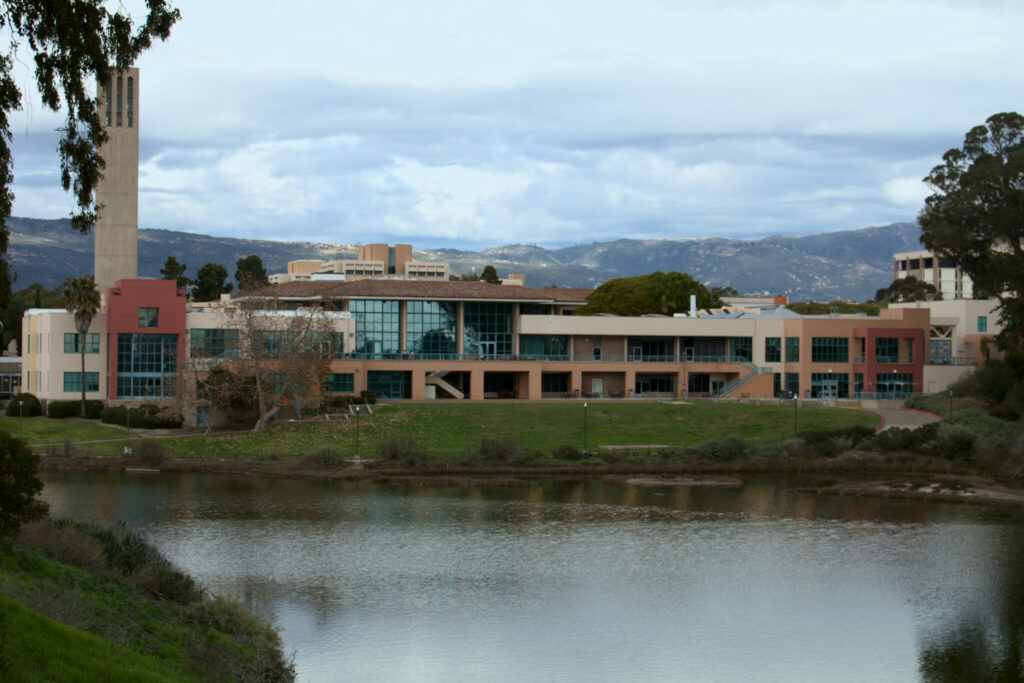Several university entities have weighed in on safety concerns near the Campus Lagoon in response to a recent sexual assault in that area on Oct. 19. According to Nexus reporting, sexual assault and attempted abductions have been a longstanding issue that has largely gone unaddressed until recently.

The lagoon remains an area on campus with a longstanding history of sexual assaults, attempted abductions and robberies. Nexus File Photo
The UC Police Department (UCPD) led its annual lighting and safety walk around campus on Nov. 5, with the addition of a route around the lagoon in response to the recent attempted assault. Throughout the walk, Student Safety Partners recorded locations where community members recommended additional lights or blue boxes, emergency phone stations that contact campus police when pressed.
According to UCPD Interim Chief of Police Matthew Bly, all additional light proposals will be shared with UC Santa Barbara Design, Facilities & Safety Services for consideration, and UCPD has increased the number of high-visibility uniformed patrolling in the general lagoon area to “enhance safety.”
Despite years of reports of sexual assaults, attempted abductions and robberies near the lagoon, the area remains mostly unlit. According to Associated Students (A.S.) Internal Vice President and fourth-year history and global studies double major Enri Lala and First President Pro Tempore and second-year political science major Evan Sussman, regulations under the California Coastal Commission have prevented sufficient lighting around the lagoon.
The 1976 Coastal Act permanently created the California Coastal Commission, an agency committed to the protection of California’s coast through the regulation of sustainable development. The lagoon is part of California’s coastal area, so the commission must approve any development in the area. Additionally, the lagoon’s Environmentally Sensitive Habitat Area (ESHA) designation makes developments especially difficult.
“I think in part the school didn’t want to put up a battle against the state. The commission has historically been a very powerful part of state politics, and I think we’re seeing that start to change now,” Sussman said.
UCSB Public Relations Manager Kiki Reyes was unable to find a record of whether the University has ever sent a lagoon lighting proposal to the California Coastal Commission.
According to a staff report about the ecological importance of the lagoon, the Commission has been aware of incidents of sexual assault since 1999.
“Reported incidents over the past several years include several rapes and rape attempts; occasional flashing; and a small number of robberies, robbery attempts, and molestations. Incidents of transients sleeping and camping in remote areas of the Lagoon Island, Goleta Point, and West Lagoon Park management zones occur several times each year,” the report read.
Lala and Sussman testified before the Commission in Sacramento on Nov. 7 regarding their concerns about lagoon safety, urging them to approve future proposals for lights around the lagoon.
“We speak today not just because of one recent assault, but because of years of leaving students in the dark. With close partnership [and] the support of the UC Police Department and senior administration at UCSB, we’re reviewing data that shows a consistent pattern of danger near the lagoon. Dozens of calls related to sexual assault, rape, molestation and transient crime have been reported over the past 20 years,” Sussman said in the testimony.
Sussman said the Commission has been made aware of the lagoon’s history of violent incidents, but he felt it was important that they hear directly from students who are concerned about campus safety.
“By going to the Coastal Commission firsthand, what we wanted to do was let them know that students are struggling,” Sussman said. “Students are unsafe. They don’t feel as if their campus is protecting them and that in order for such changes to occur, all that’s needed is simply a permitting process.”
Lala emphasized that the University can maintain “both ecological sustainability and basic safety for students.” He insisted that the University take action to make the lagoon a safer area for students.
“The situation is such that students cannot walk confidently through the lagoon and its adjacent areas without fear of grave physical damage or serious trauma being occurred onto them,” Lala said.
While Sussman does not solely blame the University or the Commission for the incidents by the lagoon, he finds the situation “not acceptable.”
“It’s a disgrace that a university of such a high caliber has allowed for this systematic error to happen,” Sussman said. “I’m not blaming administration, and I’m not blaming the state, but the facts are that there are 0.8 acres on campus that are unlit at night.”
Lala said the light proposal will be sent to the Commission by the end of the quarter, and will “hopefully” be fully implemented by the end of the academic year. He emphasized that A.S. will help fund the additional lights, pending approval of the Commission.
“I mean, what better use of student fees could there possibly be than preventing grave safety concerns?” Lala said.
A.S. Take Back the Night (TBTN) is a student organization committed to educating UCSB, Isla Vista and Santa Barbara about sexual violence, as well as empowering survivors and giving them safe spaces on campus. The organization has recently created a form for students to share any negative experiences walking by the lagoon.
External Chair of TBTN and third-year history of policy, law and governance and sociology double major Cameron Curtin believes this pattern of assaults is part of a larger rape culture nationwide.
“I think we see kind of UCSB as a microcosm of current rape culture and current sexual assault culture in this country,” Curtin said.
While Curtin said TBTN has received support from administrators, she believes that the fight to get lights installed has mainly been led by student advocacy.
“I think it’s student-led activism that is really what’s driving this movement towards getting the lighting involved, but also opening up broader discussions about, like, why is UCSB a place where this is happening?” Curtin said.
Internal Chair of TBTN and fourth-year history of policy, law and governance and sociology double major Kayla Goodin stressed that these lights will not solve the problem of assaults on campus, but will simply act as a deterrent. Curtin believes a larger cultural shift must occur to see a decrease in sexual violence.
“I don’t think just lighting or blue boxes prevents sexual violence at all. It’s a deterrent, but it’s really a culture that we have at Santa Barbara, and that’s what we’re aiming to do, is provide prevention, education and bystander intervention,” Goodin said. “… But it is something tangible that we can do that can at least maybe help students feel safer and prevent some kinds of crime from occurring.”
In light of a history of incidents of sexual assaults on campus, the Daily Nexus compiled a local resource guide for students and community members who are survivors of sexual violence.
A version of this article appeared on p. 1 of the Nov. 13 print edition of the Daily Nexus.




















